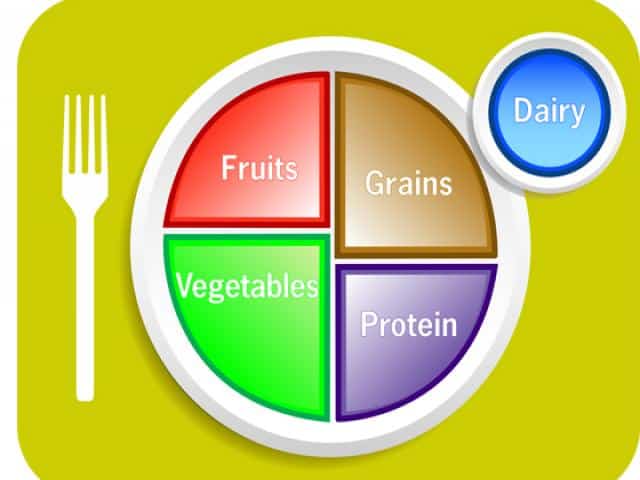Meal planning is no less than making art. The amount of thought process and intricate pre-planning that goes into creating the prefect meal which you will eat for the next few days requires sheer dedication.
Instead of using colors and a canvas, you are using proteins, fats, carbs to make your beautiful painting.
Just like any art, though, you need to learn the basics of how and where to start. We touched base with 15 experts who gave us amazing tips and life changing strategies that can help you in taking the steps forward to creating your perfect meal plan, whether its your first time or you've done it many times before!
Based on the comments we got, shared below, most of the experts agreed on the following essentials of meal planning:
- It is important to follow the Plate method
- The plate method must contain protein, health fats, produce and starchy carbs
- Fill half of your plate with colorful fruits and non-starchy vegetables
- Fill a quarter of your plate with lean protein
- A quarter of your plate with a complex carbohydrate
- When meal planning for dinners, make extra so you have enough for lunch as well
- Eat mostly plant-based foods
- When thinking of real food, think of nuts, seeds, fruits, vegetables, legumes
We’ve divided the comments into four sections: the plate method, plan head, balance is key and keep informed. Each piece is crucial in helping our readers to make informed decisions when it comes to meal planning and understanding the reasons behind why its important to do so.
The plate method
- Kelli Shallal, who is a Registered Dietician (RD), emphasises the importance of protein and produce along with fats and carbohydrates. (Hungryhobby.net)
The most important part in meal planning for anyone is to think about protein and produce, that's what the majority of your meal should be made up of. Once you've got that down, figure out where your fat is coming from. Is it in the sauce? Did you cook with it? Are you going to add it on like cheese or avocado?
Once your plate is loaded with protein, produce, and healthy fat the rest should come from starchy carbs. You may not need these at every meal and you may not need as much as you are used to, but you definitely don't need to skip them all the time. Assess your hunger and plan accordingly. Stick with the healthiest high protein/high fiber carbohydrates like brown rice, quinoa, beans, and potatoes!
- Caroline Susie, RD/LD, helps us break down the list of each food group and reminds us to make time for meal planning on a weekend or day off, so you have enough time to go to the store and prepare those health options. (Carolinesusierd.com)
It may sound elementary, but for every meal or future meal (meal planning), think "Plate Method": ½ of your plate should be veggies, ¼ protein and ¼ starch. For the best blood sugar control, it's essential to pair a lean protein and complex carbohydrate at every meal and snack. Planning ahead is a must! No plan = a plan to fail. Take the time to run to the store on your days off of work or weekend and prepare some healthy options. It's when healthy options are not easily accessible that we often make some meal mistakes.
I like to keep healthy, convenient options on hand such as:
- Proteins: lean deli meat, nut butters, canned chicken, canned tuna in water, low fat cheese, low fat cottage cheese
- Complex starches: whole wheat bread, whole wheat crackers, whole wheat pasta, brown rice, sweet potatoes, russet potatoes, low fat Greek yogurt, pulses (beans, peas and lentils)
- Veggies and fruits: whatever you will eat! Fresh fruit is a better option over juice/canned/dried. Frozen and canned vegetables are just fine!
- Other: avocados, walnuts, almonds
- Jodi shares her top tips which include following the plate model, cooking in batches to save time through the week, eating regular meals and snacks during the day, etc. One of the tips that she gives which resonates with us is to avoid going grocery shopping on an empty stomach! (Jodi Robinson, RD, CDE, PTS, RYT: Cravinghealth.ca)
My top tips for meal planning for diabetes (prevention and management) include:
- Follow the Plate Model when creating your meal plan - ½ plate vegetables (at least 2 types that are non-starchy); ¼ plate whole grains or starchy vegetables such as potatoes; ¼ plate meat or meat alternative (e.g. fish, tofu, legumes, cheese, nuts/seeds, eggs).
Keep in mind mixed dishes still apply - aim to make 50% of the dish vegetables; 25% grain/starch; 25% protein.
If it doesn't make sense to alter the recipe to be 50% veggies (e.g. lasagne or Shepherd's Pie) then add a vegetable (e.g. salad, steamed or raw) on the side. - Batch cook foods to save prep time through the week! Slow cooker dishes and casseroles are great for this. You can also make a large batch of chicken or fish and use leftover for various dishes through the week.
- Eat regular meals & snacks (to help keep your blood sugar in check). Especially if you are on certain medications, eating regularly (including a balance of high-fibre carbs, protein, and healthy fats) is essential for good blood sugar control. Create a routine to prepare your lunch and snacks the night before to avoid rushing in the morning.
- Keep your portions in check! Your palm size (or deck of cards) for protein; your clenched fist (for cooked grain or starch); and two large handfuls (at least!) of vegetables. It can help to portion out your meal ahead of time to keep your portions on par (this is easy to do when batch cooking in advance)
- Meal plan and grocery shop on a satisfied stomach - being hungry makes it difficult to keep on track no matter the best intentions for healthy meal planning and food shopping.
Plan ahead
- Dawn Clifford, PhD, RD, reminds us not to skip any meals as it can have a negative impact on your blood sugars. Keep snacks at bay in case hunger hits so that you can prevent low blood sugars. She goes on to explain why its important to plan ahead so you don’t starve yourself and wreak havoc on your body. (Motivatechange.net)
Instead of thinking ‘meal plan', flip those two words around and think ‘plan meal'. The key to managing your blood sugars is to plan meals and snacks so that you're nourishing your body regularly throughout a busy day. Plan ahead as you go about your day and consider where you will be and what food might be available. Pack snacks and meals so that when hunger strikes, you're prepared.
If you go too long without eating, you'll get irritable and hungry (also known as hangry). If you're on medication to control your blood sugars, and you miss a meal or a snack, you may even experience dangerously low blood sugars. Making matters worse, if you allow yourself to get overly hungry by going long stretches without eating, you may end up overeating when you finally sit down for a meal. Listen to your body and make the time to stop what you're doing and eat regularly throughout the day. Savor the meal or snack and notice how your body feels while you're eating. The key is to plan ahead and bring food with you wherever you go.
When planning for eating, aim to eat a variety, with a balance of food groups. Include foods high in fiber and protein, which can help prevent blood sugar highs and lows. Make a list of quick easy fiber and protein-rich meals and snacks and refer to this list each time you head to the grocery store. Examples of balanced snacks include: apple slices and peanut butter; trail mix; string cheese and some grapes; and yogurt or cottage cheese and fruit.
In terms of planning meals, no need to get fancy. Think quick, simple meals that you can assemble in a pinch, and balance out those entrees with other food groups. For example, a piece of toast with tuna and melted cheese can be easily balanced with a handful of carrot and celery sticks dipped in ranch dressing. Top some bean tostadas (canned refried beans will work just fine) with cheese, lettuce, tomato, and avocado to make it a balanced meal. Make a list of all your favorite 15-minute meals and refer to it before you head off to the grocery store, so that you come back home with specific meals in mind.
- To create a realistic and sustainable lifestyle, Cassie Vanderwall, MS, RD, CDE, CPT, reminds us to ask ourselves the following three most important questions: where will you be eating? When will you be eating? What will you eat? Once you are able to answer these questions, meal planning will be that much easier. (Onesource4wellness.wordpress.com)
When it comes to creating a meal plan, one needs to consider the what, when, and where and often in reverse order:
- Where will you be eating? We all know that the best place to eat is in a distraction-free environment such as a table with good company. But, if life leads you to dining in the car, at your desk or on the sidelines at a child's practice than we need to choose foods that fit these circumstances.
- When will you be eating? While metabolism is individualized- everyone's body uses energy at a different rate- most people benefit from eating a meal or snack every 3 to 4 hours. If we eat too frequently, the blood sugar continues to climb because the body doesn't have time to use the energy it is taking in. Therefore, most meals plans have 3 meals and 2-3 snacks each day.
- What will you eat? Well-composed meals have at least three food groups and include a variety of food groups, ideally a source of energy (fruit or grain), protein (to stabilize the energy) and a source of fiber (vegetables). Snacks ideally have two different food groups and include a source of energy (grain or fruit) and protein or healthy fat such as apple with peanut butter or a light yogurt and ounce of nuts. Snacks can also be carb-free. These are great choices when the blood sugar is normal but you are feeling true hunger cues.
- The most important aspect of meal planning is that it is realistic and sustainable; it must meet your lifestyle.
- If you plan ahead of time and are realistic about your food choices, you do not have to say goodbye to your favorite foods. Here is how Deborah suggests you can say yes to all your cravings. (Deborah Tagliareni, MS, RD, CDN: Milestonenutrition.com/)
You don't need to give up your favorite foods when you receive a diabetes diagnosis. With advance meal planning, all foods can be a "yes".
- Tip #1: Use the plate method for choosing foods. Think about filling up half of your plate with non-starchy vegetables, having lean protein on a quarter of the plate and carbohydrates on the other quarter of your plate. You can include rice, a starchy vegetable or even a piece of fruit, as long as it doesn't take up more than ¼ of your plate.
- Tip #2: Plan your meals a few days in advance. This will help keep your carbohydrate intake similar at each meal and help keep your blood sugar stable throughout the day.
- Tip #3: Be realistic about portion sizes that you eat. Use measuring cups to serve yourself at home so that you can quickly estimate how many carbs are on your plate when you're eating out.
Balance is key
- Kristina LaRue, RD, CSSD, reminds us that balance is key. A simple but often forgotten concept. (Loveandzest.com)
Balance is key. If you're craving sweets or a dessert, it's okay to give into that sweet tooth. To keep blood sugar in check, incorporate sweets into the meal by forgoing the bread basket, potato, or rice at dinner and instead opt for a double serving of non-starchy vegetables or a side salad and enjoy your dessert too.
- Mix your plate with colorful fruits and vegetables. Learn to balance your carbs by substituting real carbs with vegetable “carbs”. Kristyn Hall, Nutritionist and Dietitian, also recommends learning to do an “eating forcast”. Read more to find out how you can do just that! (Energizenutrition.ca)
- Make carbohydrate substitutions to help manage the total amount of carbohydrate you eat in check. You could add in some spiralized zucchini into your pasta, use coconut water in your smoothies instead of juice, use avocado instead of bananas in your smoothie and experiment with nut and coconut flours in place of wheat-based flours in your baking.
- Develop your portion-size “literacy” even for healthful foods. Most of us are lousy at estimating the amount of rice we put on our plate, the amount of dressing we pour on our salads, and the amount of protein on our plate. And while I love encouraging people to use their plate to guide what foods they put on their plates, there is still lots of room to over-eat large portion sizes. Grab some measuring cups, spoons and a kitchen scale, and remind yourself what does a ½ cup portion of rice looks like. What does a 1 cup portion of salad look like. What does 1 tablespoon of salad dressing look like? How much is 3 ounces of meat/fish/poultry.
- Brighten up your plate with vegetables and fruits in new ways. Incorporate this Maple Apple Compote. Enjoy this Crunchy Peach Salsa for a snack. Try this Citrus Thai Mango Slaw. Snack on these Strawberry Basil Bites. Make up a batch of these Vegetable Rice Paper Wraps. For a lighter supper, try this Mediterranean Kitchen Sink Salad. For a refreshing smoothie, try this Mango Kale Smoothie.
- Learn to do an eating forecast. Just like a weather forecast, where you might pack along a sweater if it is going to be cold, do a forecast for the day ahead. What do you have planned? Where and when will you be able to access your food? Are there anticipated challenges where eating could be a struggle? An upcoming all-day meeting? A BBQ with friends? A road trip?
- Jennifer M. Ephraim, RD, CSO, CNSC, CDN, reminds us not to forget about the sweet sleep and the benefits of exercising to keep your blood sugars under control. (Tigrisnutrition.com)
Getting adequate sleep and exercise are two ways to help blood sugar control. For diabetics, I would recommend regulating your blood sugar metabolism by eating at the same times every day and having the same amount of carbohydrates at each meal. Consuming good helpings of salad for lunch and dinner made with non-starchy vegetables can go a long way in helping to regulate blood sugar, as well as, promoting weight loss for those who are overweight. Additionally, following a low sodium and low-fat diet can also help with blood sugar management. Make sure the animal protein consumed is lean. Prediabetics would also benefit from these tips to help avoid or delay the progression of their condition to full blown diabetes.
- Lisa suggests that if you are having trouble understanding how much carb they need to consume, it may be time to seek the expert help of a registered dietician. (Lisa Hugh MSHS, RD, LDN, CWCA, AACCWS, CPHQ, CLT: Southernmarylanddietitian.com)
For meal planning, I encourage my clients to stick with the right amount of carbs, to plan on eating what their body needs, and not trying to go carb free. A lot of people try to eat less than what their meal plan calls for. This can cause low blood sugar, hunger, eventual over eating, and general dissatisfaction with meals...not to mention big fluctuations in blood sugar. If a client doesn't know how many carbs to eat at each meal, a Registered Dietitian can help.
- If you are having trouble with planning for meals only once a week, consider planning for them three days out of your week. When meal planning, Andrea Miller, MHSc and RD, also reminds us not to forget about including beverages in the mix. (Amillerrd.ca)
- Plan dinners at least three days out-as you are planning, write your grocery list. You can do this electronically, or on paper- but keep the meal plans and the grocery list, with a goal to create a file of meal plans and a perpetual grocery list. This will save so much time, in the long-run.
- When planning dinners, keep lunches in mind. Cook extra for lunches. As you serve dinner, put the extra in your lunch containers, to decrease the temptation to eat second servings. Portions are managed, and lunch is made, all in one go!
- Pre-cut veggies for more than one meal at a time. If you are cutting peppers and onions for your pasta sauce, cut extra for the stir fry, for the next day; or just cut extra and freeze the cut veggies in labelled zip-lock bags. Pull out the cut veggies for soups, stews, etc.
- Cook extra meat or chicken in single serving portions. Enjoy one portion at the meal, refrigerate or freeze the rest, so it is available to take out (in single serving portions) for another meal.
- Cook extra rice and quinoa- after serving dinner, store the extra in a labelled freezer bag- freeze it for another dinner. If you have pre-cooked rice, pre-cut veggies, left over chicken- dinner can be ready in minutes and portions are pre-managed.
- Try a new food and a new recipe each week- this keeps boredom from setting in, it can increase nutrient intake and it can widen cooking skills.
- Include snacks in your meal plan and grocery list. Planned snacks help with blood sugar management and can decrease trips to the drive through or vending machine. Snacks should include a protein and a whole grain or a fruit or vegetable- such as peanut butter and apple slices or hummus and whole wheat pita, or nuts and grapes.
- Plan for beverages! If you like flavoured water- make sure you plan to buy lemons, cucumbers, mint, or other flavour enhancers. This can decrease the urge for soft drinks or other sweetened beverages.
Keep informed
- With so much information out there on meal planning for diabetes, which one do you follow? Who do you listen to? Crystal Cascio, MS, RD, CDN, reminds us to go back to the basics by eating real food, mostly plans. Read on to see what she means by real and whole foods. (Crystalcascionutrition.com)
Eating well for pre-diabetes and diabetes can understandably feel overwhelming at times. We are faced with so much conflicting information on health from the media, institutions and peers on what to eat and how to eat it. I would argue that a diabetic meal plan is actually delicious and should be enjoyed! The best advice I have to give? Well, I can't help but think of Michael Pollans famous words, "Eat Food. Not too much. Mostly plants".
Eating real, whole foods that are rich in flavor and color is a great place to start! What do I mean by real, whole foods? Think nuts, seeds, fruits, vegetables, legumes (such as beans, peas, lentils) and whole grains (such as quinoa, oatmeal, buckwheat, etc.) Try filling half of your plate with colorful fruits and non-starchy vegetables, a quarter of your plate with lean protein (can include plant and/or lean animal protein), and a quarter of your plate with a complex carbohydrate (whole grains or starchy vegetables). Don't forget to include a healthy source of fat at each meal as well! Most importantly: experiment with new foods, have fun & enjoy!
- Learn about your taste pallets: what do you enjoy? Elizabeth encourages you to find ways to make a dish more enjoyable and diabetes friendly for you. (Elizabeth Ann Shaw, MS, RDN, CLT: Shawsimpleswaps.com)
When planning out your meal plan, I like to encourage individuals to think about the foods they enjoy. Often times when trying to plan a diabetic meal plan people forget to think about the foods they like to eat rather than the foods they think they should have. For instance, if you enjoy Italian food, I help clients find creative ways to enjoy their classic favorites with more nutrient dense swaps. In place of a traditional white pasta, I'll discuss the benefits of whole grain choices while also showing how fun and delicious vegetable-based pasta noodles can be! I think the biggest part of the meal plan process is to remind yourself that small changes can make a big difference. Don't overhaul your diet overnight! Focus on a few things you can change each week, in the end, it'll add up.
- Use the internet to your advantage. How? Emily Kyle, MS and RDN, shares more with us. (Emilykylenutrition.com)
I always encourage clients to utilize the power of the internet to their advantage when working on their diabetic meal plans. The internet provides many wonderful, free resources that can help families to learn how to meal prep, eat better, and enjoy healthy foods more. Utilize trusted resources like blogs from registered dietitians and large, well-know organizations for recipe inspiration, meal prep ideas, and more. Making a diabetic meal plan doesn't have to look the same for everybody!
- Information starts within you. Learn more about your body and your mindset before you seek further. Janine Elenko, RD, provides us with a number of important to-do checklist for when you embark on your meal planning journey. (Ignitenutrition.ca)
- Start with a mind-set check. It can be easy to get wrapped up in what you need to limit or remove from your diet which can start feeling very restrictive. Try emphasizing foods you can add into your diet to make the meal planning process a more positive experience.
- Get a fiber boost. Typical North American eating patterns miss out on getting enough fiber. It's not just important for colon health, but also plays a role in blood sugar management. Try adding:
a. Fruits and vegetables with the skin. Berries also provide a great source of fiber.
b. Whole grains such as wild rice, quinoa, barley, and oats.
c. Beans, legumes, and lentils at least twice a week. - Protecting your heart: Heart health is an important part of diabetes management. Aim to include at least 2 meals each week of fatty fish such as tuna, salmon, mackerel, herring, and trout to boost up your omega-3 fatty acid intake.
- Increase your complexity: Carbohydrates that are in their nature-found state such as whole grains (oats, barley, quinoa, wild rice, etc) and starchy vegetables like winter squash (butternut, acorn) and sweet potatoes take more work for your body to break down and will raise your blood sugar more gradually than their refined counterparts. Plus, you will get more fiber!
- Aim for consistency: Eating meals 4-6 hours apart helps to provide your body with a consistent intake of carbohydrates with adequate time in between meals to help stabilize your blood sugar levels.
- A perfect pair: When eating carbohydrates at meals or snacks, pair it with a protein source. The protein helps acts as breaks in your digestive system, slowing down the process of the carbohydrate raising your blood sugar.
We hope that this expert panel has given you the tools to begin your meal planning journey!
Are there tips in there that you have been using for yourself? Did you learn something you hadn't thought of before?
Do you have any hacks that weren't shared here but which have saved your life when it comes to meal planning? Please share your comments with us!
TheDiabetesCouncil Article | Reviewed by Dr. Christine Traxler MD on May 24, 2020







